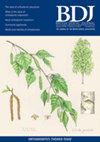SNOMED-CT and learning health systems for NHS dentistry - a dream needing to become reality
IF 2
4区 医学
Q2 DENTISTRY, ORAL SURGERY & MEDICINE
引用次数: 0
Abstract
There has been discussion and confusion about SNOMED-CT (systematised nomenclature of medicine clinical terminology), learning health systems (LHSs) and their relevance in dentistry. This article aims to provide an overview of SNOMED-CT, LHSs and the all-too-often omitted patient and service benefits from their use. LHSs are delivering impactful benefits to patients and services globally in medicine. There are some examples in dentistry, but these are few and lack the nationalised co-ordinated efforts supporting general medical practice (GP) electronic health record (EHR) databases. These impacts require research and insights from large-scale, linked EHR databases, for which SNOMED-CT will greatly facilitate. This opinion piece discusses SNOMED-CT, LHSs and the current state of EHR databases in dentistry with comparison to medical practice. Impactful examples of GP EHR database research are presented, as well as the potential benefits and disadvantages of EHR-based approaches in dentistry. Barriers to creating large dental EHR databases in the UK are discussed and potential solutions offered. Lastly, there is a call to action for multiple stakeholders, including dental clinicians, patients, academics, public health professionals, software suppliers, commissioners, and the government to co-ordinate efforts, including that of SNOMED-CT implementation, so that dentistry does not get excluded from the benefits of integrated LHSs.

SNOMED-CT和NHS牙科学习健康系统-需要成为现实的梦想
关于医学临床术语系统化命名法(SNOMED-CT)、学习卫生系统(lhs)及其在牙科中的相关性一直存在讨论和混淆。本文旨在概述SNOMED-CT、lhs以及使用它们常常被忽略的患者和服务的好处。lhs正在为全球医学领域的患者和服务提供有影响力的益处。在牙科领域也有一些例子,但这些例子很少,而且缺乏支持全科医疗实践(GP)电子健康记录(EHR)数据库的全国性协调努力。这些影响需要从大规模的、相互关联的电子病历数据库中进行研究和洞察,而SNOMED-CT将极大地促进这方面的工作。这篇观点文章讨论了SNOMED-CT、lhs和牙科电子病历数据库的现状,并与医疗实践进行了比较。提出了GP电子病历数据库研究的有影响力的例子,以及基于电子病历的牙科方法的潜在优点和缺点。讨论了在英国创建大型牙科电子病历数据库的障碍,并提供了潜在的解决方案。最后,呼吁多方利益相关者采取行动,包括牙科临床医生、患者、学者、公共卫生专业人员、软件供应商、专员和政府协调努力,包括实施SNOMED-CT,以便牙科不会被排除在综合lhs的好处之外。
本文章由计算机程序翻译,如有差异,请以英文原文为准。
求助全文
约1分钟内获得全文
求助全文
来源期刊

British Dental Journal
医学-牙科与口腔外科
CiteScore
3.10
自引率
15.40%
发文量
1096
审稿时长
4-8 weeks
期刊介绍:
The role of the BDJ is to inform its readers of ideas, opinions, developments and key issues in dentistry - clinical, practical and scientific - stimulating interest, debate and discussion amongst dentists of all disciplines. All papers published in the BDJ are subject to rigorous peer review.
 求助内容:
求助内容: 应助结果提醒方式:
应助结果提醒方式:


